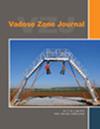井下土壤水分传感器校准方法体积密度和含水量变化的复杂性
IF 2.5
3区 地球科学
Q3 ENVIRONMENTAL SCIENCES
引用次数: 2
摘要
井下土壤体积含水量(VWC)传感器用于接入管中,以评估多个深度的土壤含水量。如果传感器读数在垂直方向上间隔足够近,并且足够准确,那么可以在读数的深度范围内确定准确的土壤剖面含水量存储和存储变化,如果读数延伸到根区以下,则可以准确估计蒸散量(ET)。即使传感只覆盖活动根区,土壤水分消耗也可以很好地确定,从而为灌溉计划提供信息。虽然传感器的精度取决于许多因素,包括传感器的物理工作原理,但通常需要土壤特定校准才能获得良好的精度。在具有不同质地、堆积密度(BD)或化学成分的多个层(层)的土壤中,可能需要进行特定层的校准。我们描述了用于井下传感器校准的方法和设备,其典型精度小于0.01 m3 m−3,具体参考了土壤中10个中子散射仪的校准,该校准需要三种不同的特定层位校准。我们的结果与工厂校准形成对比,工厂校准会导致1.5米深的土壤剖面中储存的水出现38毫米的误差。我们描述了测量的VWC和BD随深度、距离和含水量的变化,以及使用BD将质量基(g g−1)含水量数据转换为VWC数据所产生的误差,对于1.5米深的土壤剖面中的土壤蓄水量,这可能高达35毫米(低估7.26%)。本文章由计算机程序翻译,如有差异,请以英文原文为准。
Methods for downhole soil water sensor calibration—Complications of bulk density and water content variations
Downhole soil volumetric water content (VWC) sensors are used in access tubes to assess the soil water content at multiple depths. If sensor readings are spaced closely enough vertically and are accurate enough, then accurate soil profile water content storage and change in storage can be determined over the depth range of readings, leading to accurate estimates of evapotranspiration (ET) if readings extend to well below the root zone. Even if sensing only covers the active root zone, soil water depletion may be determined well enough to inform irrigation scheduling. While sensor accuracy is dependent on many factors, including the sensor's physical principle of operation, soil‐specific calibration is typically required for good accuracy. In soils with multiple horizons (layers) of different texture, bulk density (BD), or chemical composition, horizon‐specific calibrations may be necessary. We describe methods and equipment used for downhole sensor calibration to typical accuracy of <0.01 m3 m−3 with specific reference to calibration of 10 neutron scattering meters in a soil that required three different horizon‐specific calibrations. Our results contrast with the factory calibration, which would result in a 38‐mm error in water stored in a 1.5‐m deep profile of our soil. We describe variability of measured VWC and BD with depth, distance, and water content and the errors that result from using BD to convert mass basis (g g−1) water content data to VWC data, which can be as much as 35 mm (7.26% underestimation) for soil water storage in a 1.5‐m deep profile of our soil.
求助全文
通过发布文献求助,成功后即可免费获取论文全文。
去求助
来源期刊

Vadose Zone Journal
环境科学-环境科学
CiteScore
5.60
自引率
7.10%
发文量
61
审稿时长
3.8 months
期刊介绍:
Vadose Zone Journal is a unique publication outlet for interdisciplinary research and assessment of the vadose zone, the portion of the Critical Zone that comprises the Earth’s critical living surface down to groundwater. It is a peer-reviewed, international journal publishing reviews, original research, and special sections across a wide range of disciplines. Vadose Zone Journal reports fundamental and applied research from disciplinary and multidisciplinary investigations, including assessment and policy analyses, of the mostly unsaturated zone between the soil surface and the groundwater table. The goal is to disseminate information to facilitate science-based decision-making and sustainable management of the vadose zone. Examples of topic areas suitable for VZJ are variably saturated fluid flow, heat and solute transport in granular and fractured media, flow processes in the capillary fringe at or near the water table, water table management, regional and global climate change impacts on the vadose zone, carbon sequestration, design and performance of waste disposal facilities, long-term stewardship of contaminated sites in the vadose zone, biogeochemical transformation processes, microbial processes in shallow and deep formations, bioremediation, and the fate and transport of radionuclides, inorganic and organic chemicals, colloids, viruses, and microorganisms. Articles in VZJ also address yet-to-be-resolved issues, such as how to quantify heterogeneity of subsurface processes and properties, and how to couple physical, chemical, and biological processes across a range of spatial scales from the molecular to the global.
 求助内容:
求助内容: 应助结果提醒方式:
应助结果提醒方式:


